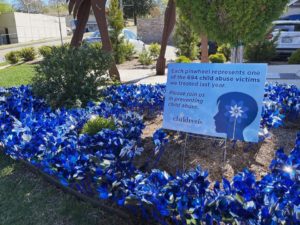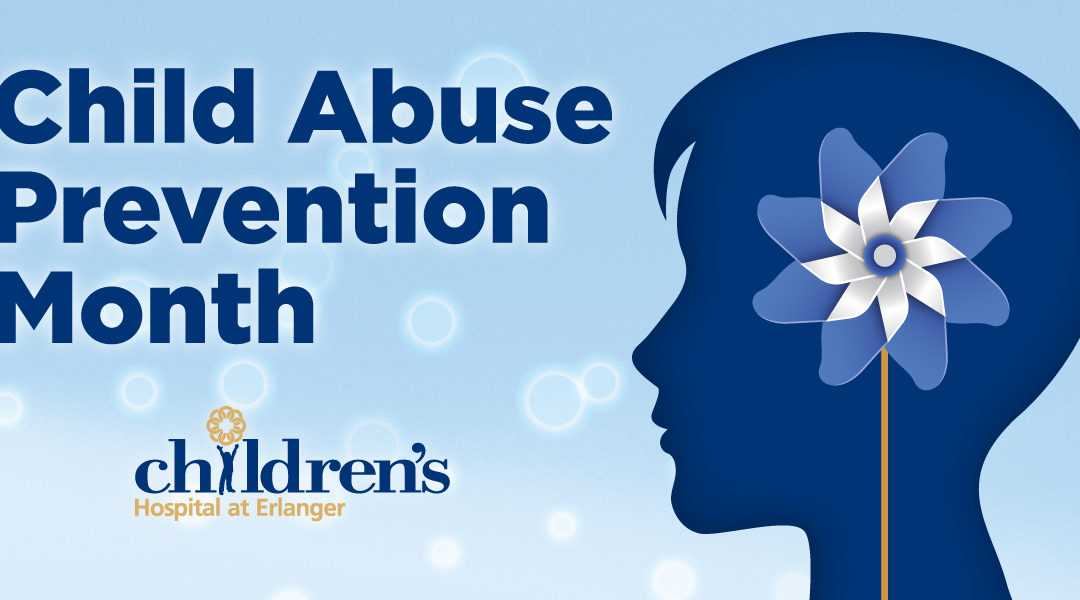 Each of the 694 pin wheels on display in front of the Children’s Hospital at Erlanger Kennedy Outpatient Center represents a local victim of child abuse we treated in 2020 — a staggering 51% increase from 2019. This sobering display, an annual project for National Child Abuse Prevention Month, serves as a reminder of the important role each of us plays in working together to prevent child abuse and neglect in our communities.
Each of the 694 pin wheels on display in front of the Children’s Hospital at Erlanger Kennedy Outpatient Center represents a local victim of child abuse we treated in 2020 — a staggering 51% increase from 2019. This sobering display, an annual project for National Child Abuse Prevention Month, serves as a reminder of the important role each of us plays in working together to prevent child abuse and neglect in our communities.
But before we can think of solutions, we first have to truly understand the issue. Read on for some insight.
Defining child abuse
You might think of child abuse as physical abuse alone. But it’s more than that.
Child abuse is defined as when a parent or caregiver causes injury, emotional harm or even death to a child, whether by taking an action or by failing to act. More than that, even putting the child at risk of serious harm is considered child abuse.
Many forms of mistreatment fall under the umbrella of abuse, including neglectful behavior, exploitation, emotional abuse, physical abuse or sexual abuse. These types of abuse are also called “adverse childhood experiences” or ACEs.
Identifying child abuse
One of the most important steps we can take to prevent child abuse is to know how to identify the signs of each type of abuse.
Physical abuse is any type of action that injures a child, even if it’s not intended to cause injury. If a child is being physically abused, he or she may have:
- visible injuries at multiple stages of healing
- injuries that can’t be explained or that are explained in an odd way
- aggression toward others
- a variety of emotions including fear, depression and anxiety
- nightmares or insomnia
- mood swings or defiant behavior
Emotional abuse occurs when a parent or caregiver harms a child’s mental or social development or causes severe emotional harm. Emotional abuse is almost always present when another form of abuse is found and can have more long-lasting negative psychiatric effects than either physical abuse or sexual abuse. If a child is being emotionally abused, he or she may have:
- developmental delays or learning disabilities
- health issues, including ulcers
- bed-wetting
- nervous behaviors like rocking back and forth
- extreme mood swings
- anti-social behaviors
Behaviors to look for in the parent or caregiver include belittling, rejecting, ridiculing, blaming, scape-goating, and bullying the child or children. They may create an environment of terror, fear, and/or violence and often deny the child of their emotional response. Other behaviors — which may be more difficult to spot since they most often happen behind closed doors — include isolating, exploiting, corrupting or confining the child.
Sexual abuse is the use of a child for sexual purposes or in sexual acts. This can be perpetrated by either an adult or an older child. If a child is being sexually abused, he or she may have:
- difficulty sitting or walking
- frequent urinary tract infections or yeast infections
- sleep disturbances or a fear of bedtime
- poor self-image or a lack of confidence
- eating disorders
- sexual behavior
Child neglect is also considered abuse and occurs when a parent or other caregiver doesn’t provide the care, supervision and other support necessary for a child’s health, safety and well-being. If a child is being neglected, he or she may have:
- a disheveled appearance, with clothing that’s dirty or not the right size
- frequent or extreme hunger
- low body weight
- sleepiness or fatigue
- hygiene problems
- truancy from school or incomplete homework
- complaining of abandonment such as being left at the park or at home alone for extended periods of time
If you believe a child is being harmed or see evidence of child abuse, report your suspicions to the local police or the Child Protective Services department immediately.
What can be done to prevent child abuse

Knowing the signs and taking action to document and report suspected abuse is step one in preventing further abuse. But how can you prevent it from happening in the first place?
The most important steps take place within the family. As a parent, it’s important to recognize your own behavior and remain in control of your emotions.
Never discipline your child when you’re angry. Wait until you have a chance to regain control of your emotions before taking steps to talk through what your child did wrong. Consider what your child is experiencing and what the situation feels like to him or her.
If you feel that you or someone else who cares for your child may be exhibiting abusive behavior, seek counseling or other resources to protect your children. Advocates at The National Domestic Abuse Hotline are available 24/7 at 1-800-799-SAFE (7233).
As a parent, you’re also responsible for helping your child defend his or herself against potential abuse from others. You can do this by getting to know your child’s friends, truly listening to your child, being aware of changes in your child’s behavior or mood, and paying attention to those around your child.
You can also empower your child by teaching him or her what to do if you’re ever separated while away from home, teaching him or her to speak up when something is wrong, and teaching him or her about private body parts.
If you suspect abuse, call 1-877-54-ABUSE (22873).
Your child’s pediatrician can offer insight into this and other complex topics. Looking for a pediatrician you can trust? Find one here.







